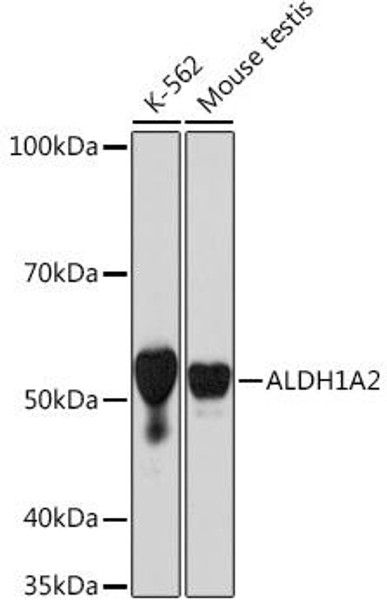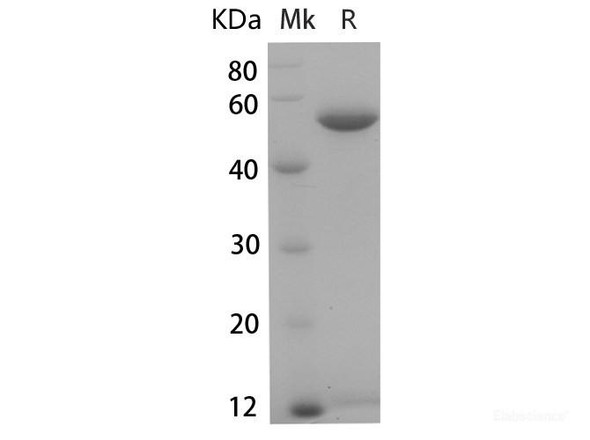Description
Anti-ALDH1A2 Antibody (CAB9123)
The ALDH1A2 Polyclonal Antibody (CAB9123) is specifically designed for research involving ALDH1A2, a key enzyme involved in the oxidation of retinaldehyde to retinoic acid, an essential molecule in the regulation of gene expression and cell differentiation. The antibody is produced in rabbits and is highly specific to human samples, making it ideal for use in Western blot applications.ALDH1A2 is a critical player in the retinoic acid signaling pathway, which is involved in numerous physiological processes such as embryonic development, cell proliferation, and differentiation.
Dysregulation of ALDH1A2 has been implicated in various diseases including cancer, metabolic disorders, and developmental abnormalities.By utilizing the ALDH1A2 Polyclonal Antibody in research, scientists can accurately detect and analyze the expression levels of ALDH1A2 in different cell types and tissues, providing valuable insights into its role in disease pathogenesis and potential therapeutic targets. This antibody is a valuable tool for researchers in the fields of developmental biology, oncology, and metabolism.
| Product Name: | ALDH1A2 Rabbit mAb |
| Product Code: | CAB9123 |
| Size: | 20uL, 50uL, 100uL |
| Synonyms: | RALDH(II), RALDH2, RALDH2-T |
| Applications: | WB, IHC |
| Reactivity: | Human, Mouse, Rat |
| Host Species: | Rabbit |
| Immunogen: | A synthesized peptide derived from human ALDH1A2 |
| Applications: | WB, IHC |
| Recommended Dilutions: | WB 1:500 - 1:2000 IHC 1:50 - 1:200 |
| Reactivity: | Human, Mouse, Rat |
| Positive Samples: | K-562, Mouse testis |
| Immunogen: | A synthesized peptide derived from human ALDH1A2 |
| Purification Method: | Affinity purification |
| Storage: | Store at -20°C. Avoid freeze / thaw cycles. Buffer: PBS with 0.02% sodium azide, 0.05% BSA, 50% glycerol, pH7.3. |
| Isotype: | IgG |
| Sequence: | Email for sequence |
| Gene ID: | 8854 |
| Uniprot: | O94788 |
| Cellular Location: | Cytoplasm |
| Calculated MW: | 57kDa |
| Observed MW: | 57kDa |
| UniProt Protein Function: | ALDH1A2: Recognizes as substrates free retinal and cellular retinol-binding protein-bound retinal. Does metabolize octanal and decanal but does not metabolize citral, benzaldehyde, acetaldehyde and propanal efficiently. Belongs to the aldehyde dehydrogenase family. 2 isoforms of the human protein are produced by alternative splicing. |
| UniProt Protein Details: | Protein type:EC 1.2.1.36; Cofactor and Vitamin Metabolism - retinol; Oxidoreductase Chromosomal Location of Human Ortholog: 15q21.3 Cellular Component: perinuclear region of cytoplasm; cytoplasm; cytosol Molecular Function:aldehyde dehydrogenase (NAD) activity; 3-chloroallyl aldehyde dehydrogenase activity; retinal binding; retinal dehydrogenase activity Biological Process: neural tube development; embryonic forelimb morphogenesis; retinoic acid receptor signaling pathway; heart morphogenesis; retinal metabolic process; neural crest cell development; positive regulation of apoptosis; vitamin A metabolic process; response to estradiol stimulus; response to vitamin A; anterior/posterior pattern formation; neuron differentiation; negative regulation of cell proliferation; morphogenesis of embryonic epithelium; retinol metabolic process; pancreas development; determination of bilateral symmetry; positive regulation of cell proliferation; retinoic acid metabolic process; kidney development; embryonic gut development; proximal/distal pattern formation; hindbrain development; cardiac muscle development; blood vessel development; regulation of endothelial cell proliferation; liver development; embryonic camera-type eye development; pituitary gland development; response to cytokine stimulus; 9-cis-retinoic acid biosynthetic process; midgut development; lung development |
| NCBI Summary: | This protein belongs to the aldehyde dehydrogenase family of proteins. The product of this gene is an enzyme that catalyzes the synthesis of retinoic acid (RA) from retinaldehyde. Retinoic acid, the active derivative of vitamin A (retinol), is a hormonal signaling molecule that functions in developing and adult tissues. The studies of a similar mouse gene suggest that this enzyme and the cytochrome CYP26A1, concurrently establish local embryonic retinoic acid levels which facilitate posterior organ development and prevent spina bifida. Four transcript variants encoding distinct isoforms have been identified for this gene. [provided by RefSeq, May 2011] |
| UniProt Code: | O94788 |
| NCBI GenInfo Identifier: | 90109797 |
| NCBI Gene ID: | 8854 |
| NCBI Accession: | O94788.3 |
| UniProt Secondary Accession: | O94788,Q2PJS6, Q8NHQ4, Q9UBR8, Q9UFY0, B3KY52, B4DZR2 F5H2Y9, H0YM00, |
| UniProt Related Accession: | O94788 |
| Molecular Weight: | 480 |
| NCBI Full Name: | Retinal dehydrogenase 2 |
| NCBI Synonym Full Names: | aldehyde dehydrogenase 1 family, member A2 |
| NCBI Official Symbol: | ALDH1A2 |
| NCBI Official Synonym Symbols: | RALDH2; RALDH2-T; RALDH(II) |
| NCBI Protein Information: | retinal dehydrogenase 2; RALDH 2; retinaldehyde-specific dehydrogenase type 2 |
| UniProt Protein Name: | Retinal dehydrogenase 2 |
| UniProt Synonym Protein Names: | Aldehyde dehydrogenase family 1 member A2; Retinaldehyde-specific dehydrogenase type 2; RALDH(II) |
| Protein Family: | Retinal dehydrogenase |
| UniProt Gene Name: | ALDH1A2 |
| UniProt Entry Name: | AL1A2_HUMAN |









